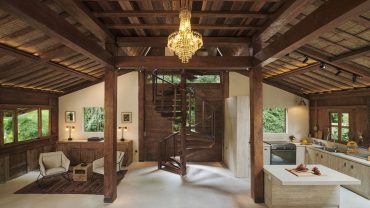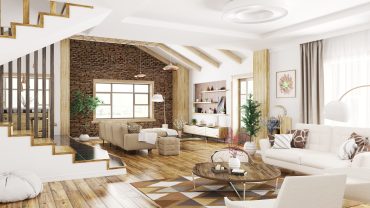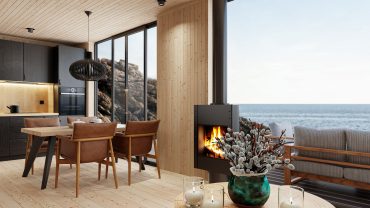It may sound like it’s straight out of Tennessee, but Memphis interior design has nothing to do with the country music capital of the US. Rather, it refers to the Memphis Milano Group, a radical design collective based in Milan, Italy.
Formed in its founder’s living room in 1980, the Memphis Group challenged conventional aesthetics with its bold colours, eccentric shapes, and a playful yet sophisticated ethos. But what exactly is Memphis Milano interior design, what’s its connection with Elvis, and how has it left its mark on the design world? That’s what we’re here to find out.
We’re delving into the origins, key features, and enduring appeal of Memphis interiors, so read on as we quell any suspicious minds.
The Origin of Memphis Milano Interior Design

Mid-century kitch interior design (Credit: Westend61 via Getty Images)
When discussing Memphis interior design, we refer to the work and style of the Memphis Milano Group. Founded in 1980 in the Milan living room of designer and architect Ettore Sottsass, this collective of creative professionals intended to disrupt the world of design. And, drawing inspiration from an array of diverse influences including Art Deco, Pop Art, and 1950s kitsch, they succeeded in doing just that. The resulting aesthetic was bold, bright and utterly unique. But, more than that, it was synonymous with rebellion against the status quo. We’ll explore the features of Memphis home decor below, but first, a burning question: what’s in a name?
Why Memphis?

Ancient city of Memphis in Egypt (Credit: Caroline Brundle Bugge via Getty Images)
With its flair for irony, it’s perhaps fitting that a collective based in Milan would be named after a completely unrelated city. But that still leaves the question, why Memphis? There are different accounts as to the reasoning behind the choice. According to some sources, it was inspired by Bob Dylan’s song “Stuck Inside of Mobile (with the Memphis Blues Again),” which played repeatedly during the group’s first meeting. However, the current website of the collective states that the name was selected because it refers both to the city in Tennessee, where Elvis Presley lived, and the ancient capital of Egypt.
The Memphis Decor Ethos

Memphis style sofa (Credit: hemul75 via Getty Images)
The Memphis Milano collective formed with a purpose, and their designs were driven by a set of principles. They were, at least in part, a reaction against mass market design, not just in terms of aesthetics, but modes of production and materials. One of the group’s main tenets was to challenge the notion of such a thing as “good” taste. Instead, they championed individuality, designing highly unusual pieces that would have an intense emotional resonance for a select audience. In other words, it was about evoking a big reaction in the few through bold design, rather than trying to please everyone. So, how did this manifest?
Key Features of Memphis Interiors

A bold living space in the Memphis style (Credit: hemul75 via Getty Images)
From flamingo-inspired coffee tables to zoomorphic lamps, Memphis decor is often described as toeing the line between kitsch and elegance. How? Well, the following represent its most prominent characteristics:
Bold Colours
At the heart of Memphis interiors was a celebration of colour and form. This style didn’t shy away from making a statement; rather, it embraced the loud and the bold. Primary colours like red, blue, and yellow were frequently used, often in stark contrast with pastels and neons. These colours were typically applied in large, solid blocks, creating a visual impact that was both striking and playful.
Unconventional Shapes
Shapes in Memphis house design were equally daring. Furniture and decor items often featured geometric forms, such as circles, triangles, and zigzags, which were used in unexpected ways. A sofa might have had a cylindrical backrest, a table might have featured asymmetrical legs, and a lamp might have been constructed from a series of stacked spheres. These elements combined to create an environment that was visually stimulating and full of energy.
Eclectic Materials
Materials used in Memphis decor further contributed to its distinctive look. Laminate, terrazzo, and plastics were commonly employed, sometimes alongside more traditional materials like wood and metal. The juxtaposition of these different textures added another layer of interest to Memphis interiors, making each piece stand out while contributing to the overall cohesion of the design.
Playful Aesthetics
Memphis interiors were characterised by a playful aesthetic that embraced whimsy and humour. The designs often incorporated unexpected elements and a sense of fun, challenging traditional notions of what interiors should look like.
Cultural References
Memphis decor often included cultural references, drawing inspiration from various artistic movements such as Art Deco, Pop Art, and 1950s kitsch. These influences were blended together to create a rich tapestry of visual and historical references.
Emotional Engagement
Designers of Memphis interiors aimed to create spaces that engaged the emotions of their inhabitants. Objects and furnishings were imbued with symbolic, poetic, and affective meanings, transforming them into more than just functional items.
Iconic Pieces
Memphis design was known for its iconic pieces that became symbols of the movement.
Notable examples included the Tahiti lamp and the Bel Air armchair, both reflecting the bold, geometric, and eclectic spirit of Memphis interiors. However, the flagship piece was the Carlton. Designed by Sottsass in 1981, it was part room divider, part bookcase, and a quirky anthropomorphic sculpture that looked like a stick figure with its hands in the air.
The Legacy of Memphis Milano Interior Design

Memphis style interior design (Credit: Phiwath Jittamas via Getty Images)
While the collective ceased its work in the mid-80s, the legacy of Memphis Milano interior design endures as one of daring and innovation. What began as a reaction against the prevailing design trends of the time has evolved into a timeless style that continues to inspire and challenge designers today. The bold use of colour, the playful forms, and the eclectic mix of materials are all hallmarks of Memphis interiors that remain relevant and influential.
Summarising Memphis Home Decor

Eye-catching Memphis interior design (Credit: Phiwath Jittamas via Getty Images)
As a ground-breaking and eye-catching design style, Memphis house design represents a unique and influential chapter in the history of design. Its bold colours, geometric shapes, and eclectic materials create a visual interior design approach that’s both playful, daring and sophisticated.












